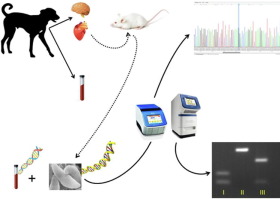当前位置:
X-MOL 学术
›
Int. J. Parasitol.
›
论文详情
Our official English website, www.x-mol.net, welcomes your
feedback! (Note: you will need to create a separate account there.)
Stray dogs in the tropical state of Chiapas, Mexico, harbour atypical and novel genotypes of Toxoplasma gondii.
International Journal for Parasitology ( IF 3.7 ) Pub Date : 2019-12-19 , DOI: 10.1016/j.ijpara.2019.12.001 Luis Fernando Valenzuela-Moreno 1 , Claudia Patricia Rico-Torres 2 , Carlos Cedillo-Peláez 2 , Héctor Luna-Pastén 2 , Sara Teresa Méndez-Cruz 3 , María Eréndira Reyes-García 4 , Dolores Correa 2 , Bruna Farias Alves 5 , Hilda Fátima Jesus Pena 5 , Heriberto Caballero-Ortega 2
International Journal for Parasitology ( IF 3.7 ) Pub Date : 2019-12-19 , DOI: 10.1016/j.ijpara.2019.12.001 Luis Fernando Valenzuela-Moreno 1 , Claudia Patricia Rico-Torres 2 , Carlos Cedillo-Peláez 2 , Héctor Luna-Pastén 2 , Sara Teresa Méndez-Cruz 3 , María Eréndira Reyes-García 4 , Dolores Correa 2 , Bruna Farias Alves 5 , Hilda Fátima Jesus Pena 5 , Heriberto Caballero-Ortega 2
Affiliation

|
Genotyping of Toxoplasma gondii remains a relevant topic of study, since genotypes can be related to the presentation and severity of toxoplasmosis. To date, 292 restriction fragment length polymorphism genotypes have been described around the world. Serosurveys in southeastern Mexico have documented exposure in over 70% of people and certain animals. Recently, we have described new genotypes and mixed infections in feral cats from Quintana Roo. Thus, the aim of this study was to genotype T. gondii and to describe its genetic variability, from naturally infected stray dogs of Chiapas, which has different geographical and climatic conditions from those found at the Yucatan Peninsula and the other parts of the country. Eleven stray dogs were captured and bled to obtain DNA, and then they were euthanized to perform necropsies and to collect target tissues. Diagnosis of T. gondii was done by quantitative real-time PCR (qPCR) and endpoint PCR. Genotyping was carried out, amplifying 12 polymorphic markers and 15 microsatellites. Atypical SAG3 gene products were cloned and sequenced. All blood samples of dogs were positive to T. gondii DNA by PCR. Two isolates were obtained from pooled heart and diaphragm tissue of two dogs. Two complete PCR-RFLP genotypes were identified (type BrIII and #28). Four animals had mixed infections. A new RFLP atypical allele for the SAG3 marker was observed; cloning and sequencing analysis of this locus revealed mixed infection by a strain identical to GT1, and one type I × II intragenic recombinant. The microsatellite analysis revealed that both isolates are atypical. Thus, atypical new genotypes of T. gondii and mixed infections were found in dogs of Chiapas. The results found here and in genotyping studies in México suggest that the southeastern region favours wide genetic diversity of T. gondii and the possible presence of virulent genotypes such as those found in central and South America.
中文翻译:

墨西哥恰帕斯州热带地区的流浪狗怀有弓形虫的非典型和新基因型。
弓形虫的基因分型仍然是研究的相关主题,因为基因型可能与弓形虫病的表现和严重程度有关。迄今为止,全世界已经描述了292种限制性片段长度多态性基因型。墨西哥东南部的血清调查显示,超过70%的人和某些动物有这种暴露。最近,我们描述了金塔纳罗奥州野生猫的新基因型和混合感染。因此,本研究的目的是对冈比亚锥虫的基因型进行描述并描述其遗传变异性,来自恰帕斯州的自然感染流浪狗,其地理和气候条件与尤卡坦半岛及该国其他地区的地理和气候条件不同。捕获了11只流浪狗并放血以获得DNA,然后将他们安乐死进行尸检并收集目标组织。弓形虫的诊断通过定量实时PCR(qPCR)和终点PCR进行。进行了基因分型,扩增了12个多态性标记和15个微卫星。非典型的SAG3基因产物被克隆和测序。通过PCR,狗的所有血液样品对弓形虫DNA都是阳性的。从两只狗的合并的心脏和隔膜组织中获得了两个分离株。确定了两个完整的PCR-RFLP基因型(BrIII和#28型)。四只动物混合感染。观察到了SAG3标记的新的RFLP非典型等位基因。对该基因座的克隆和测序分析表明,该菌株混合感染了与GT1相同的菌株和一种I×II型基因内重组体。微卫星分析表明,两种分离物都是非典型的。因此,在恰帕斯州的狗中发现了非典型的弓形虫新基因型和混合感染。在墨西哥以及在基因分型研究中发现的结果表明,东南地区偏爱弓形虫的广泛遗传多样性以及可能存在的强毒基因型,例如在中美洲和南美发现的那些。
更新日期:2019-12-19
中文翻译:

墨西哥恰帕斯州热带地区的流浪狗怀有弓形虫的非典型和新基因型。
弓形虫的基因分型仍然是研究的相关主题,因为基因型可能与弓形虫病的表现和严重程度有关。迄今为止,全世界已经描述了292种限制性片段长度多态性基因型。墨西哥东南部的血清调查显示,超过70%的人和某些动物有这种暴露。最近,我们描述了金塔纳罗奥州野生猫的新基因型和混合感染。因此,本研究的目的是对冈比亚锥虫的基因型进行描述并描述其遗传变异性,来自恰帕斯州的自然感染流浪狗,其地理和气候条件与尤卡坦半岛及该国其他地区的地理和气候条件不同。捕获了11只流浪狗并放血以获得DNA,然后将他们安乐死进行尸检并收集目标组织。弓形虫的诊断通过定量实时PCR(qPCR)和终点PCR进行。进行了基因分型,扩增了12个多态性标记和15个微卫星。非典型的SAG3基因产物被克隆和测序。通过PCR,狗的所有血液样品对弓形虫DNA都是阳性的。从两只狗的合并的心脏和隔膜组织中获得了两个分离株。确定了两个完整的PCR-RFLP基因型(BrIII和#28型)。四只动物混合感染。观察到了SAG3标记的新的RFLP非典型等位基因。对该基因座的克隆和测序分析表明,该菌株混合感染了与GT1相同的菌株和一种I×II型基因内重组体。微卫星分析表明,两种分离物都是非典型的。因此,在恰帕斯州的狗中发现了非典型的弓形虫新基因型和混合感染。在墨西哥以及在基因分型研究中发现的结果表明,东南地区偏爱弓形虫的广泛遗传多样性以及可能存在的强毒基因型,例如在中美洲和南美发现的那些。









































 京公网安备 11010802027423号
京公网安备 11010802027423号